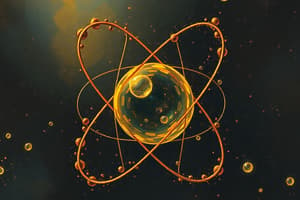Podcast
Questions and Answers
Which of the following elements has the symbol 'Fe'?
Which of the following elements has the symbol 'Fe'?
- Aluminum
- Calcium
- Iron (correct)
- Mercury
Electrons are positively charged particles found in the nucleus of an atom.
Electrons are positively charged particles found in the nucleus of an atom.
False (B)
What do protons and neutrons form within an atom?
What do protons and neutrons form within an atom?
- The chemical symbols
- The outer belt
- The electrons
- The nucleus (correct)
What are the three types of subatomic particles?
What are the three types of subatomic particles?
The center of the atom is called the ______.
The center of the atom is called the ______.
The nucleus of an atom is larger than the surrounding space that electrons occupy.
The nucleus of an atom is larger than the surrounding space that electrons occupy.
Match the following subatomic particles with their characteristics:
Match the following subatomic particles with their characteristics:
What is the chemical symbol for silver?
What is the chemical symbol for silver?
The element named after the country Germany is called ______.
The element named after the country Germany is called ______.
What do quarks combine to form in atoms?
What do quarks combine to form in atoms?
Neutrons have a positive electrical charge.
Neutrons have a positive electrical charge.
Match the elements with their symbols:
Match the elements with their symbols:
Which device is used to study quarks by colliding charged particles at high speeds?
Which device is used to study quarks by colliding charged particles at high speeds?
Which of the following statements is true regarding chemical symbols?
Which of the following statements is true regarding chemical symbols?
All chemical symbols are derived from Latin.
All chemical symbols are derived from Latin.
What is the diameter of the atomic model represented in the analogy?
What is the diameter of the atomic model represented in the analogy?
Flashcards are hidden until you start studying
Study Notes
Structure of the Atom
- Atoms consist of a nucleus surrounded by electrons; the nucleus contains protons and neutrons.
- Visual analogy: an atom's size compared to a city, with the nucleus as a fish tank and the atom's space as a 30-kilometer freeway.
Chemical Symbols and Naming
- Chemical symbols are abbreviations for elements, consisting of one capital letter or a capital letter plus one or two lowercase letters.
- Examples include C for carbon, H for hydrogen, and Au for gold, which comes from the Latin word 'aurum.'
- Elements may be named to honor scientists (like curium for Pierre and Marie Curie) or derived from geographical locations (like germanium).
Subatomic Particles
- Elements are made of one type of atom; an atom is the smallest unit retaining element properties.
- Subatomic particles include protons, neutrons, and electrons:
- Protons: positively charged, found in the nucleus, unique number per element.
- Neutrons: no charge, also located in the nucleus.
- Electrons: negatively charged, occupy space around the nucleus.
Quarks and Particle Composition
- Protons and neutrons are not the smallest particles; they consist of even smaller particles called quarks.
- Six uniquely different quarks have been identified; different arrangements of three quarks create protons and neutrons.
- Electrons are not composed of quarks.
- Study of quarks involves high-energy collisions of particles, as conducted at facilities like the Fermi National Accelerator Laboratory.
Studying That Suits You
Use AI to generate personalized quizzes and flashcards to suit your learning preferences.




